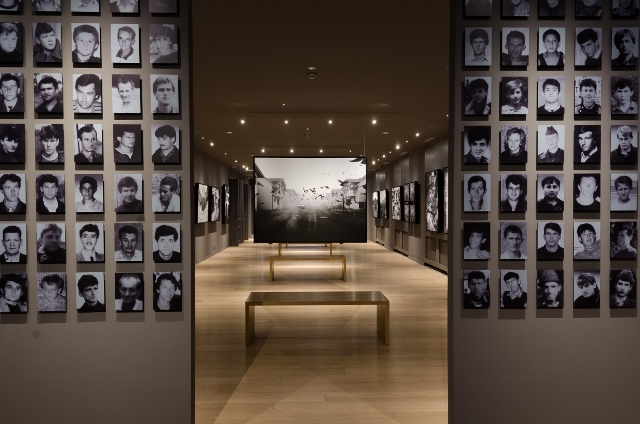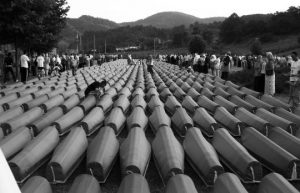HMDT Blog: ‘You are my witness’ Galerija 11.07.95 testifies to those murdered during the Genocide in Bosnia
Galerija 11.07.95 in Sarajevo, Bosnia and Herzegovina is more than just a place of memory. Its walls provide a space for the 8,000 men and boys who were brutally murdered in Srebrenica to testify to the atrocities that took place there.

Galerija 11.07.95 is a permanent exhibition that does not make passive observers of its visitors, but witnesses to the horrors that took place in Srebrenica in 1995. Its name reflects the date that General Ratko Mladić’s forces descended on the United Nations ‘safe area’ of Srebrenica and began murdering its male Muslim population. It was the first genocide in Europe since the Holocaust 50 years prior.
Survivors will later recount how they had learnt about the Holocaust in books at school, in multicultural classrooms alongside Bosnian Serb peers, never thinking that something like that would happen to their families and within their communities. 2015 is a milestone year in genocide commemoration marking two significant anniversaries: 70 years the liberation of Auschwitz, Bergen-Belsen and the end of the Holocaust; and 20 years since the Genocide at Srebrenica, Bosnia.
Galerija 11.07.95 is born from the work of Sarajevo-based Bosnian-Sudanese photographer Tarik Samarah, who grew up in Zagreb, Croatia. His 2002 project Srebrenica, genocide at the heart of Europe documented the legacy of the genocide in the town of Srebrenica. It depicts family scenes before and after the genocide, showing how communities were torn apart by the violence and its complex and powerful legacies. It shows scenes of trauma, loss and displacement in the aftermath of genocide, portraying living family members of murdered men, still residing in camps for survivors.
Samarah says that taking on a photography project became a natural and spontaneous way for him to relate to the legacy of the genocide on the entire society.
‘When you live in a society such as this one, the collective trauma becomes yours,’ he said.
‘You live with it every day. You know something big and horrible ensued. You know that you have to do something with it. Photography was the best and perhaps the only way I knew of, it was my personal need.’
Through photography, Samarah also finds ways to combat denial by documenting evidence of the genocide, using his lens to capture relics from sites of torture and murder.
‘The pain and suffering of the people who lost their loved ones becomes your duty to justify your own existence somehow. Since there are still people who deny the crimes having been committed – documentation was my first instinct,’ he said.
‘Mass graves do exist, the crimes did occur – that is a starting point. The basis of my work is a document, and the art is an upgrade to that. Art is a subtle way of evoking emotion and the individual and personal element within bigger story.’
In doing so, Samarah feels that he is helping to bring justice to the families of survivors and increasing public awareness in an atmosphere of denial.

Coffins ready for burial at Potočari. Image © Richard Newell
Through photography, Samarah helps the people of Sarajevo understand the personal impact of the genocide, for people who no doubt hold their own traumatic memories from that period of war. Tariq’s black-and-white documentary-style photographs testify to the atrocities that took place while at the same time evoking emotion through moments in people’s stories. Photographs of sites of murder show the items left behind by both perpetrators and survivors – a doll with its mouth sliced open, a wire used to tie the hands of a victim and a watch stopped at 10 minutes past five. They leave you wondering what child owned the doll, whose wrist did the watch slip from – was it torn off? What happened at that time on that fateful day?
People were killed by neighbours, school mates and even teachers. One photo of graffiti reads: ‘I am your best friend. I kill you for nothing’. It reflects the chilling intercommunity nature of the genocidal violence that ensued.
Another poignant image shows one of the mothers of the victims of Srebrenica looking on to a photograph of Anne Frank and her sister Margot outside the Anne Frank House in Amsterdam, evoking the powerful connection between these two dark events.
The experiences of survivors and victims are a central element to the gallery. The quote ‘you are my witness’ confronts you the moment you enter. As you move through the exhibition, faces and names of those murdered line the walls. Galerija 11.07.95 engages audiences through a range of multimedia content, including the video testimonies of survivors, those who bore first hand witness to the atrocities.
Tarik reflects on the reality of the horror that unfolded at Srebrenica by contextualising the number of individuals killed. He asks us to ‘try counting 8,372 to see how much time is needed to speak the numbers, then consider that each person had a name, a life’
He explains how he hopes the gallery isn’t just an exhibition or memorial space, but a place to challenge apathy and confront reality by presenting a warning.
‘The genocide is not a transhistorical occurrence that took place in some other age or a world far, far away. Similar events are unfolding in the world of today. We know that we cannot save the world but if we are able to change or enlighten an individual, that is already a tremendous success,’ Tarik said.
‘Violence becomes something natural easily. It becomes a code, a part of ordinariness, something someone believes they are permitted to use. We want to enlighten people, to try and save them from that perception of ordinariness.’
The exhibition is not the first time that Tarik has used his work publically to confront people with the genocide and challenge denial. In 2003 his photos filled billboards in cities across Bosnia and Herzegovina, and in July 2005 he ran a campaign in Belgrade, Serbia displaying his photographs on billboards across the city in an attempt to combat vehement national denial. Each bore the slogan ‘To see, to know, to remember’. Some 5,000 postcards were sent to political parties, officials, institutions and individual addresses of Serbian citizens.
Tarik understands that genocide denial is one of the stages of genocide and is aware that intolerant attitudes won’t change overnight. He is a champion for the arts as a tool to increase shared understanding of personal and traumatic stories.
‘Denial is one of genocide’s phases. It is to be expected that it exists in Bosnia & Herzegovina at the moment. People who believed in theory of ‘blood and soil’ did not change their beliefs 20 years later,’ he said.
‘However, I do believe that art focused on genocide, or any other form of violence as its theme, can offer a kind of individual truth, the one resting on the truth told by the survivors, which can be subversive when set against the backdrop of dominating ideologies.
The Sarajevo exhibition is a central and accessible location to generate understanding, knowledge and shared memory of the genocide. It invites people to bear witness to the atrocities. In doing so, it fills the audience with an understanding of the unimaginable and drives forward the need for justice.
When asked about why we should remember genocide today, Tarik said: ‘we all have a responsibility to remember events such as the Holocaust and Srebrenica as they left a profound mark on Europe, and inevitably on each of its citizens.’
Find out more
- Read Dr Mark Hoare’s blog for HMDT on which looks at the international community’s response to the Genocide in Bosnia and how far the world has come in securing justice.
- Hasan Hasanović was 19 when the town of Srebrenica fell to Bosnian Serb forces in July 1995. Read Hasan’s story.
- Visit the Galerija 11.07.95 website